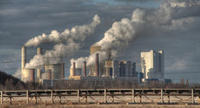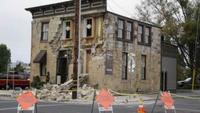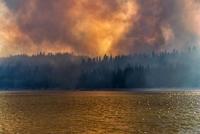-
L.A. considering first responses to the inevitable Big One
Often referred to as the “Big One,” the inevitable cataclysmic earthquake that will eventually strike at the San Andreas Fault throughout the city of Los Angeles is expected to be incredibly destructive. According to seismologists, it is no longer a question of “if,” but more just “when.” Preparedness experts identify several key parts of the greater Los Angeles infrastructure that will need to have firm response plans in place to deal with the fallout of a major disaster, specifically transportation and communication —– the two things needed to coordinate and react to everything else.
-
-
Storm-surge app improves public and administration responses to flooding
An environmental group called Wetlands Watch in Virginia has integrated crowd-sourcing into the Sea Level Rise app, allowing users to issue and receive alerts in real-time regarding waterlogged streets and improve public safety.The newest evolution of the app is expected to be launched within the next few weeks and the information provided and distributed to users will also be tracked by scientists and emergency planners to better grasp the flood patterns in the region and how to prepare for them.
-
-
Risks grow as Americans continue to build on eroding coast
More than two million housing units have been built along the nation’s coast within the last twenty years, and as the American economy recovers after years of recession, development along the U.S. coastline is steadily increasing. Scientists warn, however, that building along coastlines could put life and property at risk due to erosion, rising sea levels, and storm damage.
-
-
Flying robots will go where humans cannot
There are many situations in which it is impossible, complicated, or too time-consuming for humans to enter and carry out operations. Think of contaminated areas following a nuclear accident, or the need to erect structures such as antennae on mountain tops. These are examples of where flying robots could be used.
-
-
Blackout? Robots can help
Big disasters almost always result in big power failures. Not only do they take down the TV and fridge, they also wreak havoc with key infrastructure like cell towers. That can delay search and rescue operations at a time when minutes count. Now, researchers have developed a tabletop model of a robot team that can bring power to places that need it the most. In addition to disaster recovery, their autonomous power distribution system could have military uses, particularly for Special Forces on covert missions.
-
-
South Carolina reflects on Hurricane Hugo anniversary
The state of South Caroline has just eyed the twenty-fifth anniversary of Hurricane Hugo – the Category 4 storm that hit the coast on 21 September 1989 with sustained maximum winds of 138 mph. Many in the state still honor that event, and live with the memory of the severe coastal damage due to drastic storm surges and the forty-nine lives lost during the disaster. The storm also left 60,000 people homeless, with 270,000 temporarily unemployed and 54,000 residents seeking monetary assistance. Extending far beyond that were many others who did not have power for two weeks or longer.
-
-
Protecting the electric grid, communication systems from solar storms
Considered the strongest solar storm on record, the 1859 Carrington Event disrupted telegraph operators and crippled communications systems. Today, even mild scale eruptions could disrupt communications technology and power grids, as bursts known as coronal mass ejections cause vibrations in the Earth’s magnetic field. According to NASA, those vibrations cause electric currents that can overwhelm circuitry and lead to prolong shutdowns. Solar researchers are working to develop monitors that can predict which solar storms can disrupt electric grids and global communications systems.
-
-
Emergency notifications will soon be issued through The Weather Channel
The Weather Companywill soon issue emergency notifications to millions of U.S. residents before, during, and after disasters occur via a large-scale distribution network linked to its media properties and weather expertise. The company is forming partnerships with city and state emergency managers to build a localized alerting platform for state, local, and private emergency agencies to manage and distribute alerts via The Weather Channel, weather.com, and existing local distribution points.
-
-
New report identifies populations most vulnerable to extreme weather events
Extreme weather events leave populations with not enough food both in the short- and the long-term. A new report has looked at which sections of the population are left most exposed to food shortages after extreme weather events, and concluded that better governance could have lessened the impact on the poorest and most vulnerable, and that affected populations have been let down by the authorities in the past.
-
-
NSF awards $15 million in second round of coastal sustainability grants
More than half the world’s human population lived in coastal areas in the year 2000; that number is expected to rise to 75 percent by 2025. If current population trends continue, projections are for the crowded U.S. coast to see its population grow from 123 million people to nearly 134 million people by 2020. In wake of storms such as Hurricanes Sandy and Isaac, the NSF awards focus on better management of coastal environments.
-
-
To stay below 2°C warming, coal’s rapid phase out is essential, but not enough

A rapid phase out of coal as an electricity source by 2050 would reduce warming by half a degree, according to a new study. The study authors ran a number of scenarios around phasing out fossil fuel emissions from the electricity sector, which produces around 40 percent of global C02 emissions. The electricity sector needs to be decarbonized faster than other sectors, but instead is heading in the opposite direction, increasing carbon intensity and significantly driven by increased coal use, and making it one of the largest sources of recent carbon emission increases.
-
-
Ten years after Hurricane Ivan, Alabama communities are better prepared
Since Hurricane Ivan struck Baldwin County, Alabama and neighboring communities ten years ago, building officials have adopted better resilience protocols to protect human life and property from future storms. Ivan, which left an estimated $14.2 billion in damages throughout the Gulf Coast, is considered the worst storm to hit Alabama in twenty-five years, and the seventh most costly hurricane ever to affect the United States.
-
-
SF posting seismic warning posters on vulnerable buildings in a retrofitting drive

In an effort to get property owners to retrofit vulnerable buildings, San Francisco is posting large signs — in English, Spanish, and Chinese, with red letters, and a drawing of a collapsed building — on apartment and hotel complexes that have failed to comply with the city’s seismic safety laws.The San Francisco tactic is similar to what city officials in Berkeley implemented in 2005, when building authorities placed small warning signs on at-risk wooden apartment buildings.
-
-
Simulating the ground motion of the south Napa earthquake
Lawrence Livermore National Laboratory (LLNL) seismologists are tapping into LLNL’s supercomputers to simulate the detailed ground motion of last month’s magnitude 6.0 south Napa earthquake. The Napa tremor is the largest to hit the Bay Area since the magnitude 6.9 Loma Prieta event in 1989. Seismic simulations allow scientists better to understand the distribution of shaking and damage that can accompany earthquakes, including possible future “scenario” earthquakes.
-
-
A Santa Ana Wildfire Threat Index developed

UCLA atmospheric scientists were instrumental in the creation of the Santa Ana Wildfire Threat Index — a new tool to classify the fire threat potential of the powerful, hot, dry Santa Ana wind, which can turn a spark into an inferno. The index was introduced 17 September by the U.S. Forest Service, in collaboration with UCLA and San Diego Gas and Electric.
-
- All
- Regional
- Water
- Biometrics
- Borders/Immig
- Business
- Cybersecurity
- Detection
- Disasters
- Government
- Infrastructure
- International
- Public health
- Public Safety
- Communication interoperabillity
- Emergency services
- Emergency medical services
- Fire
- First response
- IEDs
- Law Enforcement
- Law Enforcement Technology
- Military technology
- Nonlethal weapons
- Nuclear weapons
- Personal protection equipment
- Police
- Notification /alert systems
- Situational awareness
- Weapons systems
- Sci-Tech
- Sector Reports
- Surveillance
- Transportation
Advertising & Marketing: advertise@newswirepubs.com
Editorial: editor@newswirepubs.com
General: info@newswirepubs.com
2010-2011 © News Wire Publications, LLC News Wire Publications, LLC
220 Old Country Road | Suite 200 | Mineola | New York | 11501
Permissions and Policies
Editorial: editor@newswirepubs.com
General: info@newswirepubs.com
2010-2011 © News Wire Publications, LLC News Wire Publications, LLC
220 Old Country Road | Suite 200 | Mineola | New York | 11501
Permissions and Policies
